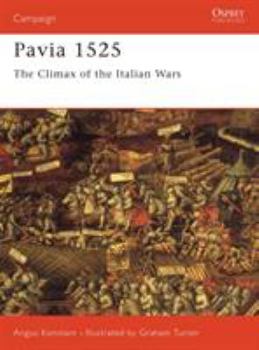Pavia 1525: The Climax of the Italian Wars
(Part of the Osprey Campaign (#44) Series and Osprey Campaign (#44) Series)
Select Format
Select Condition 
Book Overview
Osprey's Campaign title for the climax of the Italian Wars (1494-1559). The battle of Pavia has been hailed as the first modern battle, marking the rise of hand held weapons as a tool of warfare. In this titanic clash - the most decisive of the Italian Wars, caused by French territorial ambitions in first the Kingdom of Naples and then the Duchy of Milan - the French troops were smashed by the Spanish Imperial Army. King Francis I was captured, and the cream of his nobility slaughtered. France's greatest defeat since Agincourt, the battle dramatically swung the balance of power in Western Europe.
Format:Paperback
Language:English
ISBN:1855325047
ISBN13:9781855325043
Release Date:November 1996
Publisher:Osprey Publishing (UK)
Length:96 Pages
Weight:0.80 lbs.
Dimensions:0.3" x 7.3" x 9.7"
Customer Reviews
3 ratings
A Revolution in Fighting?
Published by Thriftbooks.com User , 16 years ago
The Italian Wars had been raging for over a quarter of a century when the king of France laid seige to the Italian city of Pavia. A powerful Hapsburg army marched to the rescue and eventually breached the French ring. The French were caught divided and off guard. The result was several hours of brutal fighting in which King Francis was taken prisoner, the cream of France's gendarmes (and thus many of their nobles) were shot or cut to pieces, and the legendary Swiss pikemen suffered a major blow to their reputation. In one sense, Pavia highlighted the increasing use of firearms though in truth the arquebus didn't turn the tide alone as pikemen and others played a major role. Overall, a good account of an important battle and a pretty well illustrated book as well. The author discusses not only the battle but also the lead up to it and the armies that fought it.
Excellent given the limitations of the series
Published by Thriftbooks.com User , 22 years ago
This is one of the best productions of the rather uneven Osprey series. It is unfortunately prone to the problems of sloppy editing and production which dog the series, but is still an excellent short treatment of the battle, within the limitations of the slim-volume Osprey format. It gave me my first clear insight into what went on, after floundering amongst accounts which could not even clearly identify the size and location of the hunting park in which it all happened.Konstam opens with a short but adequate summary of the strategic confrontation, already a generation old, between France and Spain in Italy, and the series of dynastic accidents which united almost all France's potential enemies, in Spain, Italy, Germany and Burgundy, under the personal rule of the Emperor Charles V. He also includes a series of excellent thumbnail sketches of the main actors. He could profitably have outlined in more detail the reasons for the generation gap which did so much to weaken the French command, but a full analysis of that issue would require a whole volume on Renaissance military sociology. His analysis of the events of the year leading up to Pavia is also thorough, within the limits of space.The reconstruction of the battle itself is lucid and convincing. One is inclined to scepticism over the precision of the timings given, but it was not a long battle and given the amount of ground to cover and the possible speed of movement, they can't be far out - and Konstam has walked the ground himself. At Pavia a major role in the destruction of the French cavalry was played by the Imperialist musketeers, which has led some commentators to claim it as marking some sort of military revolution. Konstam avoids falling into this trap; the immediate tactical cause of the French defeat was the centuries-old propensity of the gendarmerie to make mutton-headed charges against ill-selected objectives. Pavia was in many ways a transitional battle; musketry and field artillery were important, but many tactical details could have happened one, or even two, centuries earlier.In a broader perspective, the real root of victory and defeat was the marked superiority of Imperialist command and control. The French seem never to have had a coherent plan for dealing with the Imperialist army encamped on their doorstep. The Imperialists started out with a plan that was nearly the classic "surgical strike" at the French command centre and artillery reserve, but as usual the plan did not survive the first encounter with the enemy. But, with both sides facing an unexpected situation, the French could not achieve more than ad hoc reactive responses, while the Imperialists maintained an impressive degree of mutual support - famously, Frundsberg's disengagement and re-direction of his Landsknechts to de Vasto's support after breaking the first Swiss counter-attack, but also in the sortie of de Leyva's garrison from Pavia. On principle, it should have been the Imperialist command, drawn
An excellent description of a confusing battle
Published by Thriftbooks.com User , 23 years ago
Angus Konstam does an excellent job of making sense of a confusing battle. I have read several dscriptions of the battle of Pavia before, which only left me confused about exactly what happened. After this book, I finally understand the battle. The author has done some impressive research with primary sources to understand what actually happened and does a first rate job (aided by plenty of well laid out maps) explaining it. My only gripes are that the author does not do a better job describing the armies and how they fought (altho much of this can be gleaned from the battle description) and too many pages were wasted on a poorly done chapter on how to wargame the battle.






